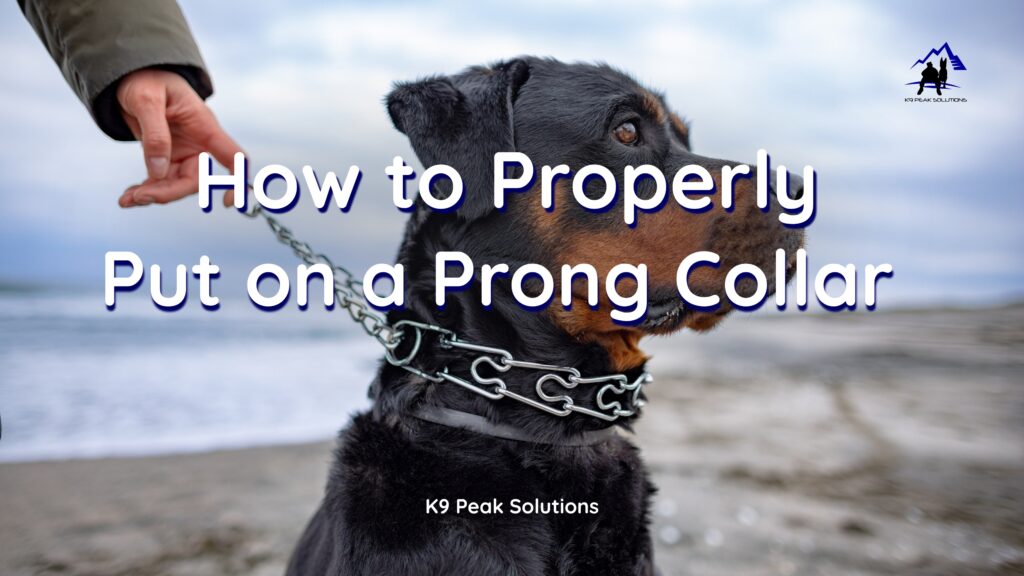
When used correctly, prong collars are an invaluable tool in dog training. They help control leash-pulling, correct unwanted behaviors, and improve leash manners—especially for dogs that struggle with excessive pulling or lack of control on walks. Whether you’re a dog owner in El Paso, TX, or working with a local trainer, understanding the proper way to use and fit a prong collar is essential for successful training. This guide will walk you through the precise steps to ensure your dog’s safety and comfort while using a prong collar for effective training.
Step 1: Preparing the Collar for Proper Fit
The first step in using a prong collar is ensuring it fits correctly. It should sit snugly but not too tight, allowing comfort while still providing control. For dogs with thick or dense fur, such as shepherds or other large breeds common in El Paso, TX, it’s essential to adjust the collar to accommodate the fur, which can sometimes make it appear tighter than it is.
Tip: Ensure that the collar isn’t baggy or loose, as that will make it ineffective. The goal is for the collar to fit securely yet comfortably around your dog’s neck.
Step 2: Positioning the Prong Collar on the Neck
Once you’ve adjusted the collar, the next step is proper placement. The prong collar should rest just behind your dog’s ears and at the top of the neck—not too low near the throat. This placement ensures the collar provides effective correction and is comfortable for your dog during training sessions.
Tip: Avoid positioning the collar too low, as this will reduce its ability to provide a firm, consistent correction.
Step 3: Rotating the Collar for Correct Alignment
As you put the collar on your dog, you’ll need to rotate it so that it sits with the prongs facing inward towards the neck. Be cautious not to rotate or twist the collar incorrectly, as this can cause discomfort or create knots, preventing proper function.
Tip: Always rotate the collar so the prongs close evenly and don’t create unnecessary pressure or discomfort for your dog. The collar should form a smooth “Martingale” effect, tightening when your dog pulls but releasing when they stop pulling.
Step 4: Ensuring the Collar is Not Tangled
Before continuing, double-check that the prong collar isn’t tangled with any other collars or leashes your dog may be wearing. This ensures that the prong collar can function properly, applying pressure only when necessary. If the collar gets tangled, it won’t provide consistent corrections, reducing its effectiveness.
Tip: Always verify that the collar is in the correct position and is not interfering with any other equipment before beginning the walk or training session.
Step 5: Applying the Correct Leash Pressure
Once the prong collar is properly positioned and adjusted, it’s time to use it for training. The prong collar works best when used with the correct leash pressure. This means giving a quick, firm correction (a leash pop) when your dog pulls or engages in undesirable behavior. This action mimics how a mother dog corrects her pups, providing immediate feedback that helps your dog understand the behavior you expect.
Tip: Always apply leash pressure with intention. Never yank or jerk on the leash harshly. A quick pop is sufficient and more effective in teaching your dog leash manners.
Step 6: When to Use a Prong Collar for Corrections
A prong collar should be used to reinforce positive behaviors, not solely to correct undesirable ones. If your dog struggles with pulling or jumping, use the collar as a tool to correct these behaviors. However, it’s important not to rely solely on the collar for corrections. Start by teaching leash pressure and basic obedience before incorporating the prong collar.
Tip: Use the prong collar for corrections after your dog understands leash pressure. For example, if your dog jumps on you during training, use the collar to provide a firm correction, teaching them that jumping isn’t acceptable.
Common Mistakes to Avoid When Using a Prong Collar
Even with the best intentions, it’s easy to fall into common pitfalls when first learning to use a prong collar. Avoiding these mistakes will ensure the collar remains a humane and effective tool for your dog’s training journey here in El Paso.
1. Leaving the Collar On Unattended:
- Mistake: A prong collar should never be left on your dog when they are unattended, especially when crated, tied out, or playing with other dogs.
- Why it’s a mistake: There’s a significant risk of the collar getting snagged on something, leading to injury, strangulation, or even death. Prong collars are training tools for active, supervised use.
- Correction: Only put the prong collar on for active training sessions or walks, and remove it immediately afterward.
2. Incorrect Sizing or Fit:
- Mistake: Using a collar that is too loose or too tight, or with too many/few links for your dog’s neck.
- Why it’s a mistake: A collar that’s too loose can sag, making it ineffective and allowing the dog to potentially slip out. One that’s too tight can cause constant pressure and discomfort. An incorrect number of links can lead to improper distribution of pressure.
- Correction: Refer to our previous guide on proper sizing and adjustment, ensuring the collar sits high and snug on the neck, just behind the ears.
3. Positioning the Collar Too Low on the Neck:
- Mistake: Allowing the prong collar to rest on the soft, lower part of your dog’s throat.
- Why it’s a mistake: This reduces the effectiveness of the collar by not engaging the correct pressure points and can put uncomfortable and potentially harmful pressure on the trachea.
- Correction: Always ensure the collar is positioned high on the neck, right behind the ears, where it can provide proper, even pressure around the top of the neck.
4. Applying Constant or Harsh Pressure (Yanking/Jerking):
- Mistake: Continually pulling on the leash, or yanking/jerking the leash aggressively.
- Why it’s a mistake: This constant pressure can cause desensitization, discomfort, or even injury, and it teaches the dog very little. Harsh jerks are painful and counterproductive.
- Correction: Use quick, firm, and immediate “leash pops” as a communication signal. The pressure should be applied and released almost instantly, mimicking a natural correction.
5. Using it as a Punishment Tool (Instead of a Communication Tool):
- Mistake: Viewing the prong collar primarily as a way to punish bad behavior, leading to frustration and anger in the handler.
- Why it’s a mistake: While it corrects, its primary purpose is to clearly communicate desired behavior. If used out of anger, it can create fear and resentment in your dog, damaging your bond.
- Correction: Approach training with a positive mindset. The prong collar is a tool to provide clear feedback, guiding your dog towards the behaviors you want to see. Pair corrections with positive reinforcement for good behavior.
Why Choose a Prong Collar for Your Dog?
Prong collars provide a humane and effective solution for leash training, especially for dogs that are difficult to control on walks. Unlike traditional collars or harnesses, prong collars apply even pressure around the dog’s neck, discouraging pulling without causing harm when used correctly. Whether training a young dog or addressing behavioral challenges with an older dog, a prong collar can be a game-changer for both you and your dog.
Conclusion
Using a prong collar correctly is an essential skill for every dog owner in El Paso, TX, who wants to improve their dog’s leash manners and overall behavior. By following these steps and ensuring the collar is properly fitted and used, you can achieve a more controlled, positive walking experience. Consistency and patience are key to successful training, so remember to start slowly and use the prong collar as an aid in reinforcing good behaviors.




Nice post! 1754723431